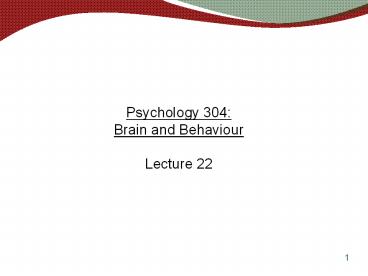Psychology 304: Brain and Behaviour Lecture 22 - PowerPoint PPT Presentation
1 / 13
Title:
Psychology 304: Brain and Behaviour Lecture 22
Description:
Four forms identified: occulta, meningocele, meningomyelocele (cystica) and myeloschisis. * Spina Bifida: Four Forms Spinal cord (yellow) * 3. – PowerPoint PPT presentation
Number of Views:138
Avg rating:3.0/5.0
Title: Psychology 304: Brain and Behaviour Lecture 22
1
Psychology 304 Brain and BehaviourLecture 22
2
Neurodevelopmental Disorders
1. What neurodevelopmental disorders have been
identified?
3
By the end of todays class, you should be able
to
1. discuss the causes, neurological correlates,
and symptoms of neurodevelopmental disorders.
4
What neurodevelopmental disorders have been
identified?
1. Anencephaly
- Occurs when the anterior neural tube does not
close, resulting in incomplete brain
development. Caused by genetic abnormalities,
folic acid deficiencies, and/or exposure to
neurotoxins.
5
Anencephaly Incomplete Brain Development
6
Anencephaly Incomplete Brain Development
7
2. Spina bifida
- Occurs when the posterior neural tube does not
close, resulting in spinal cord defects and limb
paralysis. Caused by genetic abnormalities,
folic acid deficiencies, and/or exposure to
neurotoxins.
- Four forms identified occulta, meningocele,
meningomyelocele (cystica) and myeloschisis.
8
Spinal cord (yellow)
Spina Bifida Four Forms
9
3. Down syndrome (trisomy 21)
- Occurs when an extra copy of chromosome 21 is
produced. Caused by errors in cell division.
- Associated with abnormal brain development
Abnormal dendrites, simpler and smaller gyri and
sulci, smaller frontal lobes, lighter brain.
After age 30, brain degeneration typically
occurs.
- Accompanied by mental retardation,
abnormalities in internal organs, and altered
facial and body features.
10
Down Syndrome Physical Characteristics
11
Down Syndrome Physical Characteristics
12
Down Syndrome Controversial Craniofacial Surgery
13
Neurodevelopmental Disorders
1. What neurodevelopmental disorders have been
identified?































